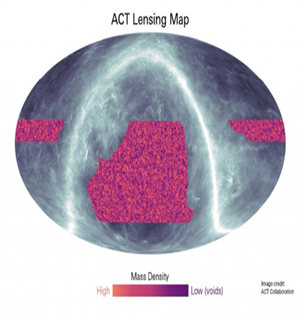

Context
Researchers have created a detailed map of the ‘hidden’ dark matter that makes up 85 per cent of the universe and mentioned that it agrees with Einstein’s theory of gravity.
What is dark matter?
- It is a hypothetical form of matter thought to account for approximately 85% of the matter in the universe.
- It forms the skeleton on which galaxies form, evolve, and merge.
- Dark matter is made up of particles that do not have a charge.
- So, these particles are “dark”, namely because they do not emit light, which is an electromagnetic phenomenon, and “matter” because they possess mass like normal matter and interact through gravity.
|
Evidence for dark matter: It comes from calculations showing that many galaxies would fly apart, that they would not have formed, or that they would not move as they do if they did not contain a large amount of unseen matter. |
About the map:
- Published by:
- This research was presented at the Future Science with CMB x LSS, a conference being held from at the Yukawa Institute for Theoretical Physics, Kyoto University.
- Researchers from the United States, Canada and the United Kingdom used a ground-based telescope, Atacama Cosmology Telescope (ACT).
- The “baby picture of the universe” has been projected which consists of a cosmic microwave background (CMB) radiation or fossil radiation has left over after the Big Bang.
Key findings:
- It proved that the Gravitational field generated by these massive objects bends and distorts light that passes through them.
- Unlike normal matter that constitutes all stars and galaxies; dark matter does not absorb, reflect or emit light.
- Dark matter only seems to interact with gravity, making it challenging to detect.
- Being invisible, researchers observe how dark matter interacts with the gravity of massive objects such as galaxy clusters and lumps of dark matter.
- The clumps of dark matter magnify the appearance of objects that lie behind.
- The researchers look for this characteristic magnification in the CMB image to map the dark matter.
- The new findings agree with the standard model of cosmology based on Einstein's theory of gravity.
Einstein's theory of gravity:
- According to the theory, he proved that a mass can prod space plenty. It can warp it, bend it, push it, or pull it.
- Gravity was just a natural outcome of a mass's existence in space.
- According to relativity, anything that can happen inside of a box picking up speed — i.e., accelerating — also happens in the presence of gravity.
- For example, a horizontal laser inside an elevator that’s accelerating upward. As the light travels sideways, the elevator rises, causing the beam to strike a spot on the wall slightly lower than where it started.
- If the elevator accelerates quickly enough, the beam visibly bends toward the floor.
- Einstein showed the same thing happens to a beam inside a stationary elevator within a powerful gravitational field; the gravity bends the light.
- Similarly, he expected a beam of starlight should bend when passing through the sun’s gravity.
|
Theory of Einstein vs. Newton:
|


